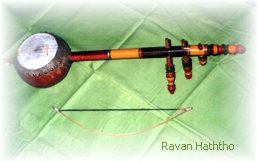|
This tradition is epitomized in the poetic theme of Sorath and Rai Diyach by the classical Sindhi poets, Shah Inayat who passed away in 1725, Shah Abdul Latif who breathed his last in 1752 and others. The words of the magnanimous chief Khenghar about the power of music and the worth of the master musician's demand are expressed by Shah Abdul Latif as follows:-
If on my shoulders I had heads more one
I would have cut each and spared none
Alas! I have but one head alone.
What a poor remunerate is this single one.
This story, along with others, references to the masterly use of the instrument by the professional bards in the courts of the Samma chiefs indicates that Surando had already become a popular and powerful instrument of music in Sind during the Samma period i.e. 1350-1520 AD. Since then, it has been continuously played on. During the Kalhora period i.e. 18th Century, it was specially patronized by Mian Nasir Muhammad who gave up ghost in 1119 AH, the founder of the Kalhora Empire were enthusiastic to the devotional Surando melodies.
Siddik Jat represented Kutch-Gujarat performing Surando in the pageant on the occasion of the Republic Day of India on 26th January, 1991 in New Delhi. On this day, he displayed his skill of Surando before the Prime Minister and the President of India and Siddik Jat was warmly greeted by the dignitaries with a wrap. Siddik Jat played his Surando in the Festival of France held in Bombay. Siddik Jat was sponsor to travel Germany and England in 1991 by the Government of India to participate in the Festival of India for cultural function where the people of both countries welcomed his art of Surando. The author of this booklet forwarded his tape to the School of music, University of Washington, U.S.A. and British Broadcasting company- London for highlighting Siddik Jat's art. Siddik Jat played his instrument in abundant cultural functions in the country and abroad. He is an approved artist of All India Radio, Bhuj and his recital of Surando broadcast over Radio and also telecast over Doordarshan Television occasionally. His interviews and reports have been in print in many newspapers and magazines in various languages in the country and abroad.

But Siddik Jat faces many hardships for his livelihood at this age of 70. His genetic profession was stock and cattle breeding. His family had about 1000 camels in the past, but due to numerous scarcities in Kutch, his family had to migrate from Kutch to South Gujarat for grazing their cattle. It was the year of 1935. a great disease spread among the cattle, most of the camels died due to be short of of medical treatment. Moreover, rest of the camels was stolen by the robbers of Madhya Pradesh. So this cattle herder family becomes helpless except doing other work to survive. Therefore, by often migration, the family of Siddik Jat has now settled in Ahmedabad for some years. Siddik Jat and his family work in a private company near Vishala Hotel in Ahmedabad. But it is very important to note that in such severe life, Siddik Jat preserved his gadget Surando for many years. He learnt Surando from his uncle at the age of about 20. And since then, he has been playing Surando for his own delight. He came into light hardly seven years ago.
Siddik Jat plays Surando in folk style imitating melodious notes known as “Kafi”. Kafi-Sufi poems created by Sufi Saint late Shah Abdul Latif Bhitai of Sind – Pakistan can be played over Surando easily. Siddik Jat can play as many as 15 melodies notes of Sufi poems like Sorath, Deshi, Dilavar, Koiyarim, Marvi, Rano etc. Each note can be played on Surando at specific time of the day. It is very difficult to learn the art of Surando. At present, Siddik Jat is only artist of Surando in Gujarat.
To produce a Surando is also difficult as to play it. It requires a special skill and experience to prepare. Very few people can make it attractive. There is none in Kutch who can make it at this time. There was Kutchi craftsman named Amadbhai Sumar Kutchi who recently died. He had settled in a town, Hansot, of Broach district for some years. He was an expert artisan of making Surando. His last piece of Surando has been displayed in Kutch Museum, Bhuj- The oldest museum in Gujarat State – in musical instrument section for public exhibition. Amadbhai, fortunately, was the cousin of Siddik Jat. Due to his death, here is none in Gujarat who can make Surando. It reveals that the folk art of Surando recital is being retreating regularly from Gujarat State. It has become a sensitive aspiration to survive Surando otherwise we shall lose this culture of Surando. Siddik Jat is restless to teach Surando to the interested people but the disciples are not coming forward to learn the art.
Tabla:
Tabla is the most important instrument of drumming group. The Tabla consists of two drums the bayan and the Dayan. The bayan is played with left hand and the Dayan is played with the right hand. The bayan is made of soil (or of copper or German silver), and the Dayan is generally hollowed out of the block of wood. Both of them are covered with skin which is fastened to leather studs. These leather hoops are stretched over the body of the drum with leather braces in the case of the Dayan. Cylindrical blocks of wood are placed between the braces and the wall of the Dayan. These wooden pieces can be pushed up or down to lower of raise the pitch.
There is a permanent covering of black material called Siyahi in the centre of both the bayan and the Dayan.
|